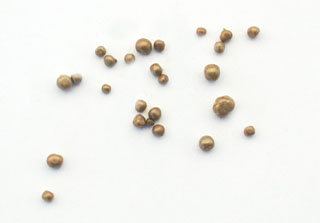
| These are typical calcium carbonate stones removed from the bladder of a castrated goat. |
Introduction:
Urinary stones (calculi) are a common problem in young, castrated male sheep and goats. If the stone actually causes the urinary bladder or urethra to rupture, this problem is often called "water belly" because of the accumulation of urine in the abdomen. Stones can also form in the female but very rarely cause a problem because of the large size of the urethra. Males that are castrated at a very young age have a much smaller penis and urethra, leading to easier blockage of the urethra by small stones. The disease occasionally affects breeding rams or bucks. The stones usually lodge in either the sigmoid flexure, a large "s" shaped curve of the penis just behind the scrotum; or in the urethral process, which is an extension of the urethra that protrudes several centimeters beyond the end of the penis.Causative Agents: Several factors, most relating to diet, contribute to the development of urinary stones. Some stones develop when goats and sheep are fed high levels of concentrates that tend to be high in phosphorus. Others develop when grass and cereal grains make up most of the diet or when forages high in oxalates (Halogeton) are eaten. Anything that causes the animal to drink and urinate less or increases the urine pH can also enhance stone formation. The most commonly formed stones are calcium phosphate (apatite), magnesium ammonium phosphate (struvite), silicate, oxalate, and calcium carbonate.
Clinical Signs/Diagnosis: Animals with urinary stones may act uncomfortable, vocalize, and show a "humped-up" appearance. Observing the animal staining to urinate is common, but may not be observed in all cases. The abdomen is often distended, especially if rupture of the bladder has occurred. If the urethra has ruptured, swelling along the penis will be observed, indicating the presence of urine in the tissues in this area. If a rupture has occurred, the animal may act lethargic and go off feed. Close examination of the animals affected with the disease will often reveal crystals and/or bloody urine adhered to the hair fibers around the prepuce or opening of the penis along the belly wall. Sometimes the location of the blockage can be felt or seen when examining the lower part of the urethra and the urethral process. Other times, this problem can be identified when an attempt is made to place a catheter into the bladder.
Treatment: Treatment of affected animals can be rewarding, especially if the condition is diagnosed soon after the problem begins. Amputation of the urethral process, a quick and simple procedure, is performed if the stone is lodged in this structure. In cases where the stone is located farther up the urethra, a catheter can be inserted and sterile saline used to try and flush out the stone(s). There are different surgical procedures that can be used in more severe cases. These procedures are often not very successful, and the chances of recovery are greatly decreased if rupture of the urinary bladder or urethra has already occurred.
Prevention: Preventing the development of urinary stones is much more rewarding than treatment. Prevention of this problem focuses on diet and proper supplements. One important preventative measure is to have a proper calcium-phosphorus ratio of approximately 2:1 in the diet. Chemical analysis of the ration, especially of the forage portion, is advisable so that the proper levels of calcium can be fed. Avoid over feeding grains, and feed a grass/alfalfa hay mix if available. When feeding only grass hay, calcium supplementation may be required. Calcium levels are easily increased by the addition of dicalcium phosphate or calcium carbonate (limestone) to the ration. Lowering the pH of the urine (acidification of the urine) may be necessary in many situations. This is accomplished by the addition of 0.5-2.0% ammonium chloride to the ration. Ammonium sulfate in slightly higher amounts will also satisfactorily acidify the urine. When dealing with small groups of animals, feeding 90 mg/lb/head/day of ammonium chloride will help prevent the problem.
An ample supply of fresh water at all times is also important for prevention. In severe outbreaks, veterinarians may also recommend the addition of up to 4 percent salt in the ration to increase urine output and thus dilute the mineral content of the urine. When this is done, it is especially important to make sure that plenty of clean, fresh water is available at all times.
 |
|